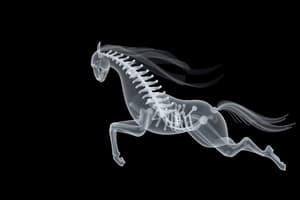Podcast
Questions and Answers
Which of the following best describes displacement?
Which of the following best describes displacement?
- Rate of change of distance
- Change in position (correct)
- Location of an object
- Total path length traveled
Velocity and speed are the same since both measure how fast an object is moving.
Velocity and speed are the same since both measure how fast an object is moving.
False (B)
What is the formula for acceleration?
What is the formula for acceleration?
a = Δv/Δt
The slope of a ________-time graph represents velocity.
The slope of a ________-time graph represents velocity.
Match the following terms with their definitions:
Match the following terms with their definitions:
Which equation represents the relationship between final velocity, initial velocity, acceleration, and time?
Which equation represents the relationship between final velocity, initial velocity, acceleration, and time?
In projectile motion, the vertical and horizontal components of the motion are independent of each other.
In projectile motion, the vertical and horizontal components of the motion are independent of each other.
What is the approximate acceleration due to gravity?
What is the approximate acceleration due to gravity?
In free fall, the only force acting on an object is ______.
In free fall, the only force acting on an object is ______.
Which of the following quantities is a scalar?
Which of the following quantities is a scalar?
Flashcards are hidden until you start studying
Study Notes
Motion in One Plane
Concepts of Motion
- Definition: Motion is a change in position of an object with respect to time and a reference point.
- Types:
- Translational Motion: Movement in a straight line.
- Rotational Motion: Movement around an axis.
Displacement, Distance, and Position
- Displacement: Vector quantity; change in position (final position - initial position).
- Distance: Scalar quantity; total path length traveled.
- Position: Location of an object in a frame of reference.
Speed and Velocity
- Speed: Scalar quantity; rate of change of distance (distance/time).
- Average Speed: Total distance divided by total time.
- Velocity: Vector quantity; rate of change of displacement (displacement/time).
- Average Velocity: Total displacement divided by total time.
Acceleration
- Definition: Rate of change of velocity over time.
- Formula: ( a = \frac{\Delta v}{\Delta t} )
- Types:
- Positive Acceleration: Increase in velocity.
- Negative Acceleration (Deceleration): Decrease in velocity.
Equations of Motion (Uniform Acceleration)
- ( v = u + at )
- ( s = ut + \frac{1}{2}at^2 )
- ( v^2 = u^2 + 2as )
- Where:
- ( v ) = final velocity
- ( u ) = initial velocity
- ( a ) = acceleration
- ( s ) = displacement
- ( t ) = time
- Where:
Graphical Representation
-
Position-Time Graph:
- Slope represents velocity.
- Straight line indicates constant velocity.
-
Velocity-Time Graph:
- Slope represents acceleration.
- Area under graph gives displacement.
Free Fall and Projectile Motion
-
Free Fall:
- Motion under the influence of gravity alone.
- Acceleration due to gravity (( g )) is approximately ( 9.81 m/s^2 ).
-
Projectile Motion:
- Motion of an object thrown into the air, subject to gravitational acceleration.
- Can be analyzed into horizontal and vertical components.
Key Points
- Motion is relative and depends on the observer's frame of reference.
- Displacement is more informative than distance in understanding motion.
- Understanding acceleration is crucial for analyzing changes in velocity.
- The equations of motion provide a framework for solving problems related to linear motion.
Concepts of Motion
- Motion involves a change in an object's position relative to time and a reference point.
- Two main types include translational motion (straight line movement) and rotational motion (movement around an axis).
Displacement, Distance, and Position
- Displacement is a vector quantity representing the change in position (final position minus initial position).
- Distance is a scalar quantity that measures the total path length traveled.
- Position refers to the specific location of an object within a defined frame of reference.
Speed and Velocity
- Speed is a scalar quantity indicating the rate of distance traveled (calculated as distance divided by time).
- Average speed is determined by dividing total distance by total time taken.
- Velocity is a vector quantity that measures the rate of change of displacement (calculated as displacement divided by time).
- Average velocity is found by dividing total displacement by total time.
Acceleration
- Acceleration is defined as the rate at which velocity changes over time.
- The formula for acceleration is ( a = \frac{\Delta v}{\Delta t} ).
- Positive acceleration indicates an increase in velocity, while negative acceleration (deceleration) signifies a decrease.
Equations of Motion (Uniform Acceleration)
- Key equations include:
- ( v = u + at ) (final velocity)
- ( s = ut + \frac{1}{2}at^2 ) (displacement)
- ( v^2 = u^2 + 2as ) (relationship between velocity and displacement)
- Variables in equations include final velocity (v), initial velocity (u), acceleration (a), displacement (s), and time (t).
Graphical Representation
- A Position-Time Graph shows velocity as the slope; a straight line indicates constant velocity.
- A Velocity-Time Graph illustrates acceleration as the slope, with the area under the graph representing displacement.
Free Fall and Projectile Motion
- Free fall is movement solely under gravitational influence, with acceleration due to gravity (( g )) approximately ( 9.81 m/s^2 ).
- Projectile motion occurs when an object is launched into the air, affected by gravitational acceleration and can be broken down into horizontal and vertical components.
Key Points
- Motion is relative, varying with the observer's frame of reference.
- Displacement provides more informative insight into motion compared to distance.
- An understanding of acceleration is essential for analyzing velocity changes.
- The equations of motion serve as a fundamental framework for solving linear motion problems.
Studying That Suits You
Use AI to generate personalized quizzes and flashcards to suit your learning preferences.




